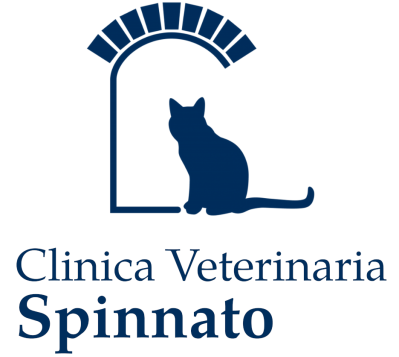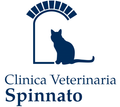Hyperthyroidism - Spinnato Veterinary Clinic
FELINE HYPERTHYROIDISM
The thyroid gland produces thyroid hormones and consists of two lobes located in the front part of the neck of all mammals, both animals and humans. It is a superficial gland, easily palpable if it increases in size.
The function of thyroid hormones is to regulate all aspects of metabolism.
Feline hyperthyroidism is an endocrine disease caused by an excess of circulating thyroid hormones.
Before treatment

After treatment

Excessive amounts of thyroid hormones accelerate metabolism causing serious consequences and multiple severe clinical signs such as weight loss despite increased appetite, nervousness, hyperactivity, tachycardia, vomiting and/or diarrhoea, dull and unkempt coat, polydipsia…
Over time, untreated or poorly controlled feline hyperthyroidism leads to harmful effects on vital organs of the cat such as the kidneys, heart, and liver. The clinical picture can worsen with the onset of heart failure, kidney and liver diseases, chronic emaciation, and/or severe metabolic dysfunctions that eventually lead to death.
Hyperthyroidism generally occurs in cats older than 8 years. In 97% of cases, it is due to an adenoma or adenomatous hyperplasia of the thyroid, and in 80% of cases, it is bilateral. Only 2-3% of cases are caused by thyroid carcinoma.
If your cat shows one or more of the clinical signs listed, contact your veterinarian who can examine him and perform a blood test to request the thyroid hormone assay from the laboratory and check if he is hyperthyroid or not.
What are the treatment options for feline hyperthyroidism?
Spontaneous remission of hyperthyroidism never occurs, and the goal of treatment is to normalise circulating thyroid hormone concentrations as quickly as possible. Finally, even in Italy, cats with hyperthyroidism have the same treatment options as people. There are four treatment options for hyperthyroidism:
1) Medical therapy with drugs that suppress thyroid hormone production. With this type of therapy, the tumour continues to grow and increase in size, and over time, benign tumours can become malignant. Managing hyperthyroidism with these medications may seem like the simplest and most affordable option available, but this often proves false, as the drug can have serious side effects and must be administered for the rest of the cat’s life. Antithyroid drugs (methimazole, carbimazole) do not cure the cat or destroy the tumour cells responsible for the disease. With these drugs, it is very difficult to keep the thyroid hormone levels within the normal range for many months. Thyroid tumours continue to grow during methimazole or carbimazole administration. Many cats, after a few years, develop very large thyroid tumours, and some benign thyroid tumours become malignant (thyroid carcinomas). Cats undergoing treatment with an antithyroid drug require careful monitoring to evaluate its therapeutic effectiveness and possible development of adverse effects. Adverse effects of antithyroid drugs are common and include anorexia, vomiting, lethargy, liver disease, thrombocytopenia, agranulocytosis, leukopenia, eosinophilia… It is enough to read the package inserts of these medications to know what and how many the risks are, and how carefully and periodically we must monitor each cat clinically and with lab tests undergoing these therapies. Many cats treated with an antithyroid drug seem to improve but never fully restore their euthyroid state. Even if T4 (thyroxine) levels return to normal, they often continue to develop secondary cardiomyopathy. Owners must be aware of all the risks when choosing a therapy. If we consider the inconvenience of having to administer the medication twice a day for the cat’s entire life, the drug’s side effects, the progressive heart disease we cannot resolve, and the fact that we are merely suppressing symptoms by inhibiting thyroid activity without actually curing the disease, antithyroid drug therapy is rarely the best option for treating hyperthyroidism. Managing the disease with antithyroid drugs may be the best choice for cats with severe, potentially fatal concurrent illnesses (e.g., a neoplasm, severe kidney or liver disease) whose life expectancy is short. In these cases, the cost of Iodine 131 therapy may not be justified. Therapy with antithyroid drugs, if given for a certain period, can hinder the effectiveness of Iodine 131 therapy because the abnormal thyroid tissue continues to grow, requiring higher doses of radioactive iodine to destroy the tumour and cure the cat.
2) Surgical therapy (surgical removal of the thyroid tumour). Surgery is an effective treatment for hyperthyroidism but has several disadvantages and is very expensive. In 80% of feline hyperthyroidism cases, both thyroid lobes are involved, meaning the cat must undergo bilateral thyroidectomy. Furthermore, if ectopic thyroid tissue is present, hyperthyroidism is not resolved with surgery.
There is also a considerable risk of damage to the parathyroid glands during surgery, which can result in hypocalcaemia. This complication can be life-threatening and often entails significant additional hospitalisation and lifelong treatment costs.
3) Iodine-restricted diet. This type of diet can lower thyroid hormone levels but does not destroy the thyroid tumour. A commercially available iodine-restricted diet exists. However, not all clinical signs of hyperthyroidism improve with this approach. In many cases, desired improvements such as weight gain and reduced heart rate are not observed.
4) Radioactive iodine therapy (Iodine-131). Iodine-131 destroys the tumour and cures the cat. This therapy offers more advantages than surgery or drug treatment. The treatment consists of a single administration of Iodine-131, given as an oral capsule. One dose is typically sufficient to cure the cat of a disease that would otherwise continue to progress—sometimes fatally—even under antithyroid medication. The ingested iodine is absorbed by the overactive thyroid cells, which it destroys, while sparing the nearby parathyroid glands. The normal, atrophic thyroid tissue does not absorb the Iodine-131. Once the excess circulating thyroid hormone is reduced, the atrophic thyroid tissue begins to reactivate, and over time, the cat—although it may initially become hypothyroid—returns to a normal, euthyroid state.
Treatment with methimazole is not needed, and the drug must be discontinued at least one week before the Iodine-131 is administered. The main disadvantage of Iodine-131 therapy is that, after administration, the cat must stay in a specialised hospital ward for 14 to 28 days due to radioactive safety protocols.
After 14–28 days, the cat can return home completely cured, with no risk of radiation exposure to the owner. Radioactive iodine therapy is considered the best treatment—the "gold standard"—for feline hyperthyroidism because it is simple, effective, and safe, and can be used regardless of the cat's age. Since normal thyroid tissue is spared, most cats do not need any thyroid hormone supplementation. A single dose of Iodine-131 results in a cure in 95–98% of cases, and 99.8% after a second dose. Cats requiring a second dose are typically those with thyroid carcinoma.
Side effects of Iodine-131 therapy are extremely rare. If a cat is unwell after treatment, the cause is almost always something else. We must remember that we are treating a geriatric population, which may have other underlying illnesses. So, if your cat does not behave normally, or stops eating or drinking after returning home, do not wait—contact your veterinary surgeon immediately. Only after ruling out other health problems can we consider the symptoms to be an unusual reaction to the treatment.








